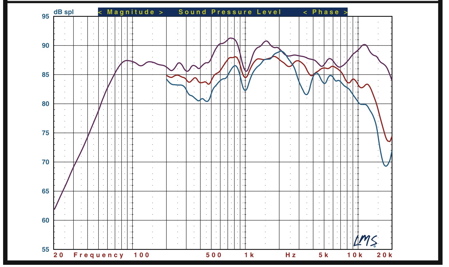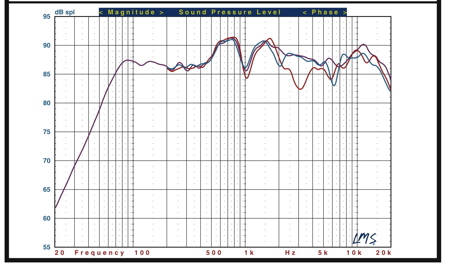Aperion Audio Intimus 633-T (II) Surround Speaker System Measurements
Measurement Conditions
From the midbass up the results shown are pseudo anechoic, taken in a real room at one meter using the LMS measurement system from LinearX Systems, gated to minimize the effects of the room. This pseudo-anechoic response is then combined with the nearfield measurements of the woofers and port.
The measurements shown were taken with the Aperions' grilles in place. The nominal impedance and sensitivity are estimates derived from the test graphs. The effective bass limit is, by our convention, is taken as the minus 10dB point in the response (relative to the level at 1kHz, unless stated otherwise). In a real room this falling response will be enhanced by room gain. The gain, and therefore the actual response, however, will vary with the room.
Measurement Summary
Both the Aperion Intimus 633-T (II) and Intimus 634-VAC should be very easy loads to drive. Any modern, properly functioning amplifier or receiver should have no problem with them.
Their measured responses are respectable at their prices. Their off-axis measurements are also good. In particular, the three-way, 634-VAC center channel speaker is relatively (but not completely) free of the off-axis response suckouts (caused by comb filtering interference patterns between drivers) that are present in nearly all two-way, woofer-tweeter-woofer center channel designs we have measured.
Details: Intimus 633-T (II)
Ported cabinet tuning: 34Hz
Minimum impedance: 4.9Ω at 118Hz
Estimated nominal impedance: 7Ω
Sensitivity: 88dB/2.83V/m
Effective bass limit (-10dB): 28Hz
Estimated difficulty to drive: Easy
Discussion: Aperion Intimus 633-T (II)
The horizontal response (Fig.1) is quite smooth, with a one notable exception: the peaks at 700Hz and 1.7kHz, with a small valley in between. This appears too low in frequency to be a culprit in the brightness heard in the listening tests. There is no other obvious evidence here of serious high frequency response anomalies. The response with the grille removed, however (not shown) is about 2dB hotter above 4kHz, though it does not have the modest bump visible around 10kHz in the graph. The speaker was clearly balanced to provide the flattest response with its grille in place.

Fig.1: Aperion Intimus 633-T (II) pseudo-anechoic response off the horizontal axis at 45 degrees (red) and 60 degrees (blue).
The horizontal off-axis response falls off relatively smoothly at higher frequencies. Note the off-axis suckout at 2kHz in the vertical response, however (Fig.2). It's most serious above the tweeter (red curve). The optimum ear height for listening to the 633-T (II) would appear to be either on or, counter intuitively, just slightly above the tweeter axis (just a few degrees above will reduce the 1.7kHz peak without risking the dip that develops at a higher, 15-degrees above.)

Fig.2: Aperion Intimus 633-T (II) pseudo-anechoic response at 15 degrees above (red) and 15 degrees below (blue) the tweeter.
Details: Aperion Intimus 634-VAC Center
Sealed cabinet tuning: 63Hz
Minimum impedance: 4.9Ω at 111Hz
Estimated nominal impedance: 8Ω
Sensitivity: 87dB/2.83V/m
Effective bass limit (-10dB): 44Hz
Estimated difficulty to drive: Easy
Discussion: Aperion Intimus 634-VAC Center
The front averaged response of the 634-VAC (Fig.3) is more uneven than the response of the 633-T (II). I was surprised, in fact, to see the double peak, with a valley in the middle, in the response from 500Hz to 2.5kHz. This caused no clearly audible coloration in my room. The peak at about 12kHz does smooth out somewhat when the grille is removed, and while this does increase the output from 7kHz-15kHz by about 2dB, the overall top end response of the 634-VAC is smoother with the grille off. This may explain why I preferred an odd configuration for serious listening: grilles on for the 633-T (II) and off for the 634-VAC.

Fig.3: Aperion Intimus 634-VAC pseudo-anechoic response off the horizontal axis at 45 degrees (red) and 60 degrees (blue).
The wide off axis curves, taken at 45 and 60 degrees, aren't as smooth as we have measured from some other three-way center channel speakers, including the smaller Aperion 533-VAC. But the latter measured much leaner through the midbass. The suckout in the 634-VAC's off-axis response at 400Hz-500Hz is likely due to the interaction between the two laterally displaced woofers.

Fig.4: Aperion Intimus 634-VAC pseudo-anechoic response at 15 degrees above (red) and 15 degrees below (blue) tweeter.
The vertical response of the 634-VAC center (Fig.4) indicates that the best vertical listening height is on or slightly below the tweeter axis.
This is a respectable set of measurements for such relatively inexpensive speakers. I would, however, like to see a smoother response in both the 633-T (II) and 634-VAC through the upper midrange, and the elimination of the off-axis dip at 500Hz in the 634-VAC.
All figures: Violet curve: pseudo-anechoic response on tweeter axis, averaged across a 30-degree horizontal window, combined with nearfield woofer and port responses. All measurements taken at 1-meter.
- Log in or register to post comments




































































